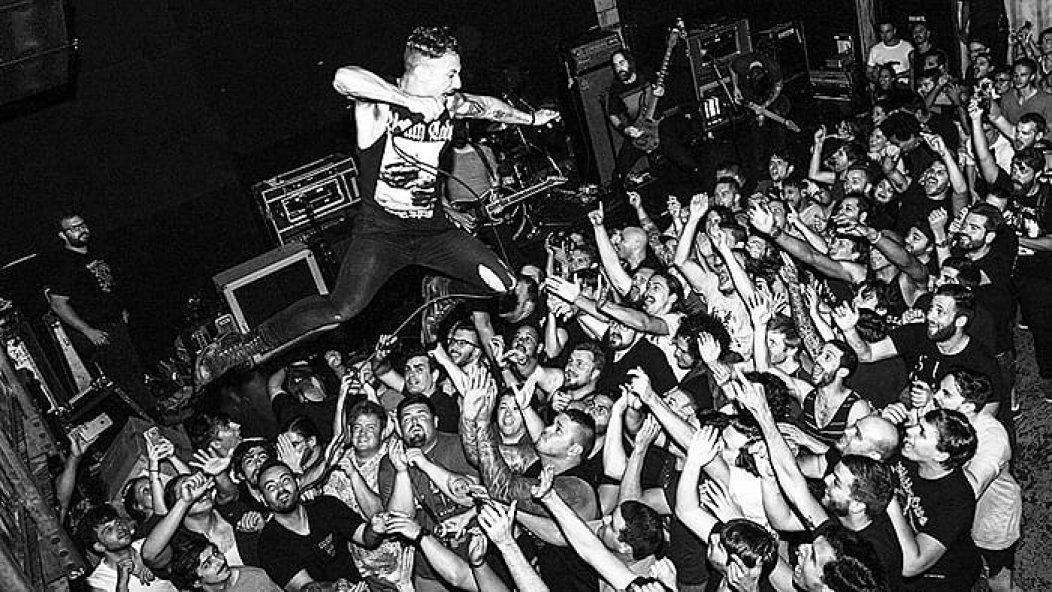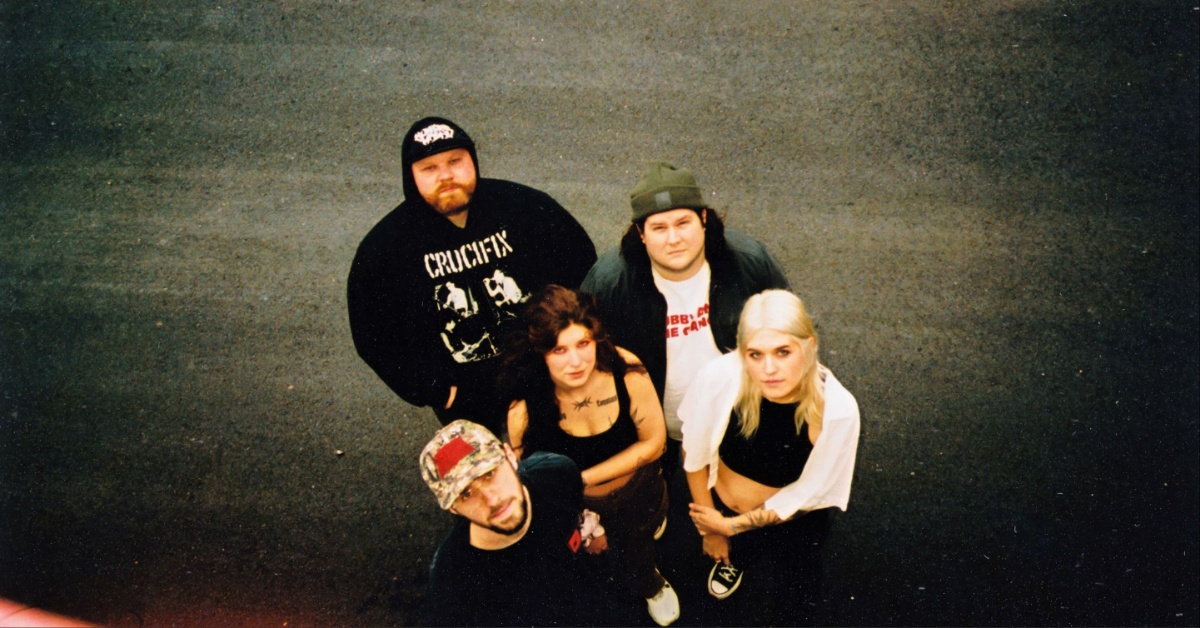
The Dillinger Escape Plan: A Body of Work
…
Five men stand on a makeshift stage inside of the Virgin Megastore in New York, NY. The store is packed, a sea of black t-shirts spilling out from the front of the stage to the balconies above. One of the five musicians, wearing a hoodie pulled up over his head, paces back and forth while the crowd buzzes with anticipation. With little to no warning the man in the hoodie rushes forward to the front of the stage, and then keeps rushing, using the heads of audience members to propel himself before the laws of physics finally catch up and cause him to collapse into the outstretched arms below. Over the din you can make out someone yelling “holy shit” as the crowd pushes back, sending the man in the hoodie tumbling back onto the stage.
…
…
Watching footage of this performance eleven years later it seems wildly improbable that the band have outlasted the stage. The Virgin Megastore closed its doors in 2009, but The Dillinger Escape Plan kept going, only recently announcing their intention to call it quits following the release of their sixth album Dissociation. The band’s performance in the Virgin video looks tame by their current standards. A quick search on YouTube yields singer Greg Puciato breathing fire out into the crowd or smeared with blood at an awards show. Recently, Puciato could be seen leaping from the balcony of Webster Hall into the arms of adoring fans.
1999’s Calculating Infinity had already earned The Dillinger Escape Plan a spot in hardcore lore, but when Puciato joined the band for 2004’s Miss Machine they transformed from a musical oddity to a tactile one. Puciato’s flexibility as a singer gave them the ability to stretch into more melodic territory, and his force of personality would serve as a muse and source of creative conflict for guitarist Ben Weinman. But it was Puciato’s capabilities as a live performer that would make him irreplaceable.
As The Dillinger Escape Plan’s reputation for unhinged live performances grew, fans learned to respond in kind, often storming the stage and wrecking as much havoc as the band. Over the course of their career The Dillinger Escape Plan have earned the reputation of being a spectacle worth seeing in person, not just because of how their music sounds live, but because you truly had no idea what was going to happen once the lights went down.
The Dillinger Escape Plan aren’t the first punk(ish) band to treat their surroundings with such reckless abandon, and they won’t be the last. Smashing a guitar is not a revolutionary act. While The Dillinger Escape Plan’s live shows will likely be mentioned in every retrospective and tribute to the band’s legacy, they were more than just a fire-breathing hot ticket.
…
…
Their early EPs and Calculating Infinity launched an arms race in the metallic hardcore scene. The record had outright copycats like PsyOpus, but even bands that didn’t start dropping jazz harmony into their songs were forced to contend with a new standard of technical dexterity. During a Q&A at Roadburn Fest 2016, Kurt Ballou of Converge joked that on The Poacher Diaries his failure to match Dillinger’s acrobatics forced him to change his focus to song structure, which in turn led him to the writing style that birthed Jane Doe. The few punk bands that could keep up were hardly punk bands at all. Between The Buried And Me might have been able to match The Dillinger Escape Plan sweep for sweep, but even from the start they were aiming for the overflowing excess of progressive rock, not the raw adrenaline of punk.
To borrow a phrase from one of their disciples, The Dillinger Escape Plan’s musicianship was always the means by which, but never the end unto itself. The complexities of their music are worthy of deep-tissue analysis (hell, founding member Chris Pennie wrote a book on the band’s rhythmic language) but there is nothing academic about the six albums The Dillinger Escape Plan have left behind. Whether or not it was intentional, the head-spinning technicality of their music did more than just send dejected musicians back to their practice space, it also connected them to a history of punk rock that aimed it’s aggression at the human body.
This may seem counter-intuitive. After all, punk rock is a notoriously no-frills discipline. The popular conception of the genre is one that views technical facility as a kind of ego-fueled indulgence, the kind antithetical to punk’s ethos. The earliest punk bands stripped away rock’s excess and recaptured the genre’s roots as pure body music. In her excellent piece on Iggy Pop for the New Yorker, Amanda Petrusich made a case for punk rock as physical expression.
“Ideologically, [punk] requires the actualization – the making real – of some otherwise unreachable pain,” Petrusich writes while describing Pop’s stage presence. “Maybe accentuating his body – and it’s frailties – was just another way in which he dismantled the boundaries between himself and the audience.”
The music that drove Iggy Pop to this state of actualization was a rough and unrefined distillation of rock music’s dance roots. It was designed to incite a physical reaction in its audience, one that would spin off from acceptable forms of dance into something more primal. Despite 30 years of distance between them and The Stooges, The Dillinger Escape Plan were making music that achieved a similar goal. The only difference is that they were drawing from a more modern dance music tradition.
“Complex electronic music has always been a huge influence on the Dillinger sound,” Weinman told Exclaim! earlier this year. “When we first started the band, I had already stopped listening to really extreme death metal.” The band made that influence explicit by including electronic interludes on nearly all of their records and by covering Aphex Twin’s “Come To Daddy” on the Irony Is A Dead Scene EP. Weinman hacked up the extreme metal tropes that he had tired of with a machete, repurposing them into a jittery, rippling cacophony, much in the same way that Squarepusher and Aphex Twin took the music of the club and re-arranged it into a heady intellectual exercise.
…
…
By using IDM as a blueprint, The Dillinger Escape Plan reverse engineered punk’s physical freedom. Their music changes meters so often that trying to find the central pulse is ultimately pointless. This means that their music is nearly impossible to dance to, in both the traditional sense as well as the “metal sense.” But just as there is no right way to react physically, there is no wrong way. The rhythmic anarchy allows for infinite interpretation. By overwhelming your nervous system with possibilities, Weinman and company set you free from worrying about being on beat. Feel like hardcore dancing? Go for it. Want to breath fire and hurl your own feces across the crowd? By all means. The only response that feels incorrect is inaction. When The Dillinger Escape Plan shudder into the opening of “43% Burnt” there is only one choice; move.
If you are afraid to move, Greg Puciato will move for you. There have been plenty of imposing physiques in heavy music, but few have weaponized their body the way that Puciato has. There is no #fitspo vanity in the way Puciato acts on stage. He treats his body like a battering ram, using it to crash against walls of other humans. Puciato is the perfect physical embodiment of The Dillinger Escape Plan’s music. Weinman smashes his guitar. Puciato smashes himself.
Both the press and Dillinger’s fans have treated Puciato’s body with a mix of adoration and bemusement. If you do an image search for Greg Puciato, the first suggested subheader is for “muscles.” In a Q&A from 2005 fans badgered Puciato with questions about weight lifting, dieting and steroids. Five years later MTV included him a listicle of musicians who may have taken steroids (Puciato was not amused).
There are all sorts of issues involving objectification and sexual discomfort bubbling under the surface of these questions and accusations, maybe in part because those subjects also find their way into Puciato’s lyrics. The Dillinger Escape Plan warped dance music into a violent nightmare, and Puciato ran dance’s physical desire through the same horrific lens. On “Sunshine The Werewolf,” a song that launched a thousand pile-ons, Puciato twists sexual satisfaction into mutually assured destruction, begging for both pleasure and nuclear fallout. The use of violence as a metaphor for human intimacy isn’t unique to The Dillinger Escape Plan, but by putting his body on the line each time he performed Puciato made the physicality of his lyrics explicit.
Dissociation will serve as The Dillinger Escape Plan’s final statement, but it won’t be their last word. The band are still in the midst of a tour across the USA before heading off to Europe. At each of those shows, barriers will break and bodies will press against bodies. The Dillinger Escape Plan aren’t slowing down. They will risk injury and wreckage and they will earn their happy ending, for soon they will have no more balconies to leap.
…










